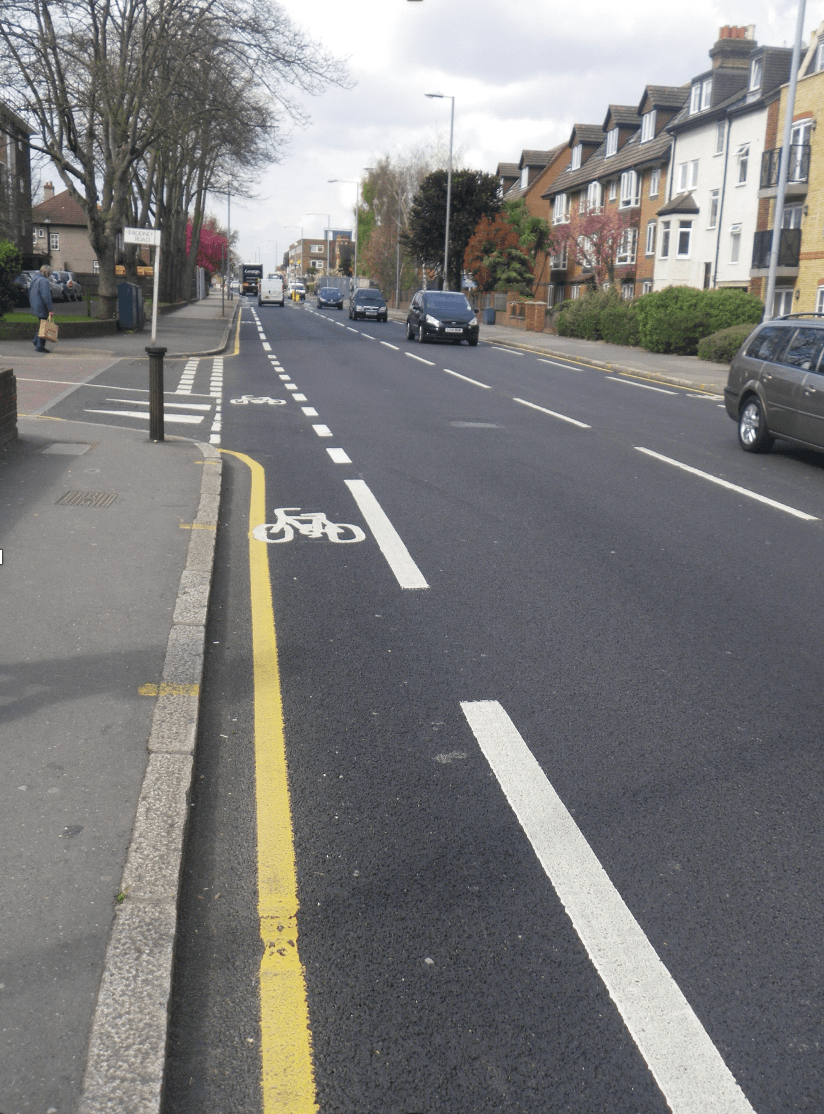 The width of cycle lanes (on carriageways) is often a matter of criticism and debate. We probably all agree that the wider a cycle lane the better, and that 1.5m to 2.0m (5ft to 6ft 6in) is preferable. The problem occurs when there is not enough width for a 1.5m cycle lane and a standard width vehicle lane of 3.0m (10ft) in each direction.
The width of cycle lanes (on carriageways) is often a matter of criticism and debate. We probably all agree that the wider a cycle lane the better, and that 1.5m to 2.0m (5ft to 6ft 6in) is preferable. The problem occurs when there is not enough width for a 1.5m cycle lane and a standard width vehicle lane of 3.0m (10ft) in each direction.
How narrow can you make a cycle lane or a vehicle lane without creating safety or comfort problems? Cyclists’ comfort is inevitably reduced with narrower cycle lanes, but to what extent does this affect safety? There is often a view amongst cyclists that narrower cycle lanes encourage closer passing of motor vehicles, but is there any proof of this?
Having been involved in cycle facilities design for many years this is a subject on which I have tried to determine the facts. Evidence is surprisingly thin, but I summarise what I know.
The standard width of cycle lanes in UK has been 1.5m, although in recent years 1.5m to 2.0m is the more general recommendation. The 1.5m came from the Dutch, in particular the comprehensive CROW ‘Sign up for the Bike’ guidance printed in 1993. Although by then UK was following the already recognised Dutch and Danish 1.5m standard with lane.
One UK report (http://ubir.bolton.ac.uk/43/1/ce_journalspr-6.pdf) has measured the passing distance of motor vehicles from cyclists with and without cycle lane markings. This showed no difference in passing clearance in 30mph limits, but increased clearances on 40mph and 50mph roads. It is this latter point that has been widely spread among cyclists.
The clearances were measured at an average of about 700mm (2ft 6in), but the closest figures were not given. The maximum differences in distance were 10% more without a cycle lane at 50mph.
In the CROW guidance their standard design recommendation is a clearance of 1.05m, less than the 1.5m that Cycling UK are currently requesting. What is not available from this UK study is any feedback on feelings of safety or comfort by the user. Also, there is no data to distinguish differences between mandatory and advisory cycle lanes, nor for different lane widths.
There is some evidence that narrow cycle lanes at junctions lead to more ‘near-misses’, and so possibly more collisions. Away from junctions there is no evidence that I have found, despite looking, that any narrow lanes have been more dangerous.
On the contrary I am aware of a number of locations in London where the introduction of 1m to 1.2m wide cycle lanes has reduced cycle collisions and been welcomed by cyclists. The reason for this could be threefold: one that motorists will probably be driving further from the kerb, and outside the cycle lane, so will have to move out less to avoid cyclists.
Secondly, narrow vehicle lanes have been shown in studies to slow traffic speeds, often by 5mph, which feels safer and would give drivers slightly more time to give cyclists adequate clearance. Thirdly, the cycle lane markings will give a continuous warning that cyclists are likely to be present. Cycle lanes past parked vehicles are a problem area unless the lanes are reasonably wide and separated by a buffer zone to avoid door opening.
Why do some cyclists think that narrow lanes encourage motorists to pass dangerously close? Maybe because with a cycle lane we think this should make us safe, so blame the cycle lane rather than the motorist. We have all probably experienced too close passes with or without cycle lanes.
More evidence about the impact of various cycling measures is needed, but unfortunately there now appears to be little research taking place. The most available statistics are in the form of road casualties which can be found on the www.crashmap.co.uk site. Here it is clear that junctions are the main problem for cyclists and other vehicles.
John Lee
RBC Coordinator for RCC

